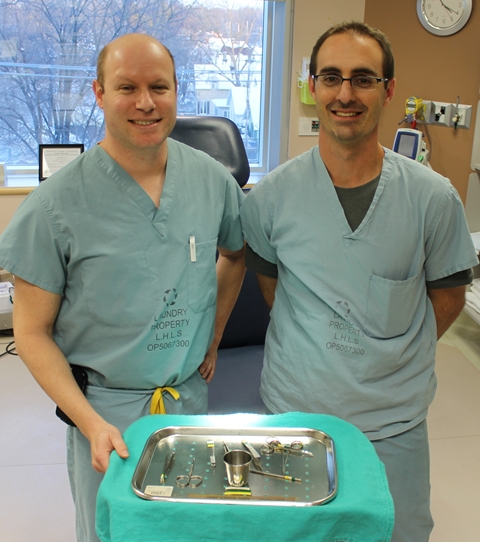
By Amanda Jackman
Financial accountability, cost savings and streamlining are very familiar terms for hospitals in Ontario. Publically funded health care organizations constantly have to find savings wherever possible. And as hospitals tighten their belts they depend on bright ideas from staff and physicians. Surgeons Dr. Leigh Sowerby and Dr. Brian Rotenberg with St. Joseph’s Health Care London’s Otolaryngology Head and Neck Surgery Program, found savings not only in equipment costs but also in time.
“As care advances there are often changes to practice that result in a different way to perform a surgery or procedure,” explains Dr. Sowerby. “We have had several instances where a surgical technique has changed but the accompanying instruments on the surgical trays did not. Tonsillectomy is a great example. Traditionally, tonsils were removed ‘cold’ – using a scalpel and a snare, but for the last 15 years at St. Joseph’s Hospital, we have been using cautery instead. The ‘cold’ instruments remained on the surgical tray, but were never used for the procedure. These instruments would have to be cleaned, reprocessed and the disposable wire replaced every time the tray was used. We wanted to take a closer look at the utilization of these trays to see if there was a cost savings by only including the instruments used regularly.”
Dr. Sowerby and Dr. Rotenberg engaged a small group of staff, and together they embarked on a study in hopes of finding a way to streamline surgical trays, which in turn would reduce costs for instruments as well as tray set up and reprocessing times.
During the study, five otolaryngology trays were audited and it was found that only 30 to 40 per cent of the instruments were used regularly. With the help of summer student Eric Lortie, Drs. Sowerby and Rotenberg worked with Tracey Yule, RN, Carmela DelVasto, Central Processing, and Pauline Bessegato, Coordinator Perioperative Services, to reduce the trays and create a new standard surgical tray. To be on the safe side they also included the creation of an ‘extras’ tray.
“The extras tray was developed just in case a surgeon needed a tool that wasn’t on the standard tray, but no one has had a need for it, so we will consider the elimination of that as well,” says Dr. Sowerby.
After the implementation of the changed trays otolaryngology has seen improvements in three areas:
Tonsillectomy (removal of the tonsils)
- Operating room set up time reduced by 32 per cent (three minutes) for tonsil trays
- Redundancies and excess eliminated by removing 20 instruments (59 per cent of the tools)
- Tonsil tray assembly time decreased from an average of nine minutes to three and a half minutes
Septoplasty (deviated septum correction)
- Operating room set up times reduced by 50 per cent (six minutes) for septum trays
- Redundancies eliminated by removing 54 instruments (64 percent of the tools)
- Septoplasty tray assembly time decreased from 22 minutes to eight minutes
Sinus Surgery
- Operating room set up time reduced by 30 per cent (four minutes) for sinus trays
- Redundancies eliminated by removing 61 instruments (60 per cent of the tools)
- Sinus tray assembly time from 26 minutes to nine and a half minutes
“One of the indirect measures we discovered was that by lowering the number of instruments, we decreased the complexity of tray assembly, which led to a shorter learning curve to train new central processing technicians and reduced stress on operating room staff,” says Dr. Sowerby.
With these positive results Dr. Sowerby knows other areas of care within St. Joseph’s would benefit from a similar exercise.
“When we made the changes in otolaryngology we presented the data to other departments. Determining the instruments to be removed requires engagement and truly is a valuable exercise.”
Word is spreading, as the Breast Care Program saw the value of reevaluating their surgical trays and is taking on the exercise. “They will be assembling new trays soon,” says Dr. Sowerby. “Both the Roth McFarlane Hand and Upper Limb Clinic and oral maxillofacial surgery have expressed interest.”
To enable this work Dr. Sowerby was awarded a President’s Grant for Innovation. “Continuous improvement is key to excellent patient care,” says the surgeon. “We want to make sure the improvements are fully meshed within our practices ensuring the best outcomes for patients and our hospital at large.”
Dr. Sowerby’s long term plan is to reach out to all St. Joseph’s surgical services and show them how his department benefited from this study and that theirs may too.
Amanda Jackman is a Communication Consultant at St. Joseph’s Health Care London.

